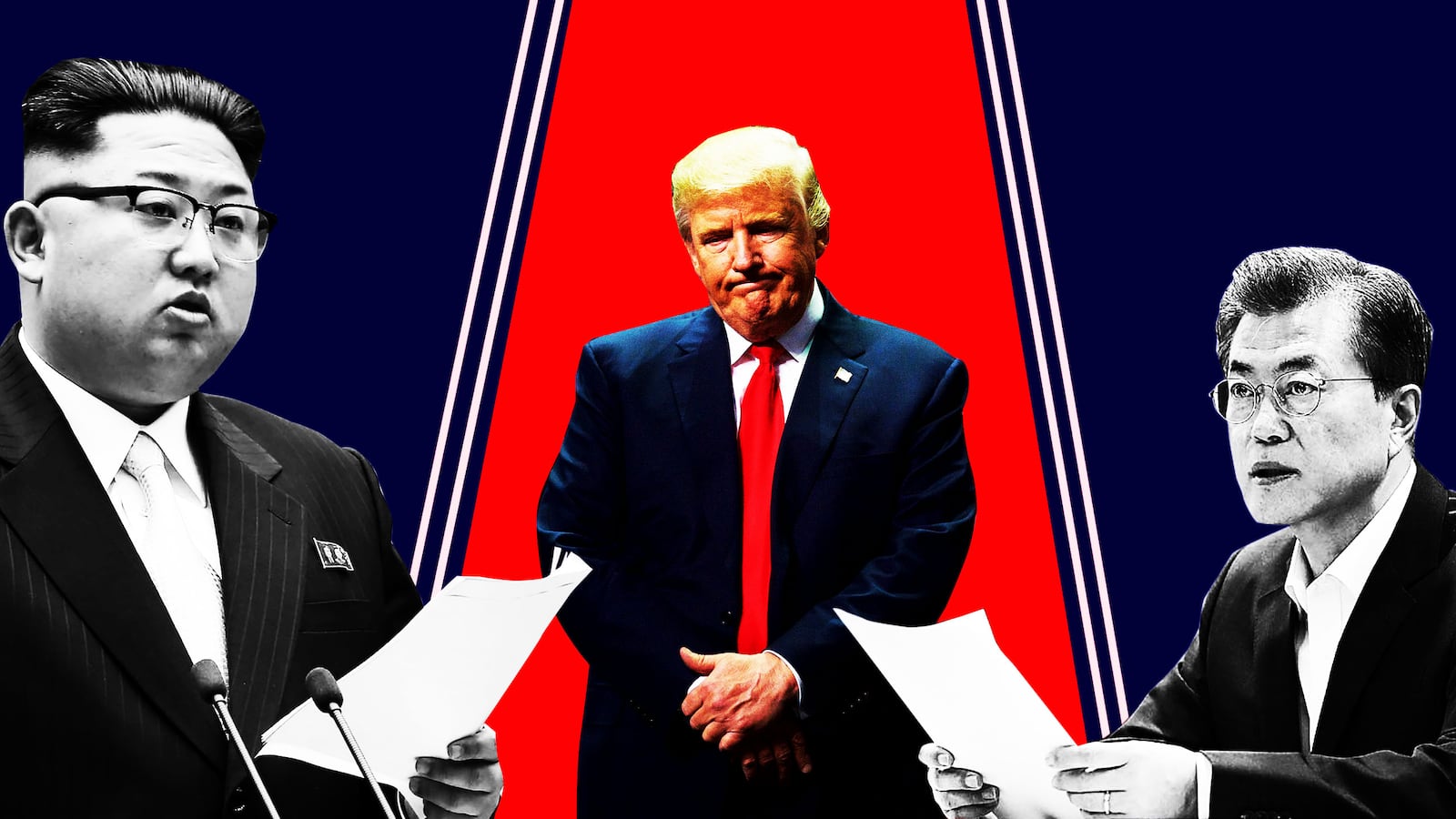In what will surely be the most important event at this year’s U.N. General Assembly session, President Donald Trump on Monday will meet North Korea’s most effective representative, South Korean President Moon Jae-in.
Moon, fresh from a three-day meeting with the North’s Kim Jong Un, is up to no good as he tries to put the best face on Pyongyang’s plans to hold on to its nuclear weapons and ballistic missiles. Never has a pig gotten such bright lipstick.
In the North Korean capital last week, Moon and Kim signed the Pyongyang Declaration and presided over the inking of a 17-page military agreement. Even taking into account the military agreement, which requires each side to pull back forces from the Demilitarized Zone and sea borders, the summit was richer in symbolism than substance, especially considering it was the third between these two leaders.
On Thursday, back in Seoul, Moon announced Kim wanted Secretary of State Mike Pompeo to return to Pyongyang and hoped for his second meeting with President Trump.
South Korea’s president said he was carrying a private message from Kim for the American leader.
Kim had been quite busy communicating with Trump, in fact. Trump, at his Friday evening rally in Springfield, Missouri, said he had received a “beautiful letter” from the North Korean on Wednesday.
Kim’s letter-writing is another indication he is trying to buy time. In Singapore in June, the young dictator signed the Joint Statement, thereby promising “to work toward complete denuclearization of the Korean Peninsula.” Then, Trump administration officials argued that Kim had made the fundamental decision to give up his arsenal.
Since then, it is clear Kim has not. In the just-signed Pyongyang Declaration, he agreed to dismantle the Yongbyon complex, which includes a uranium enrichment plant and the North’s only known plutonium-producing reactor. The dismantling would be a step forward, but Kim in the declaration made his offer conditional on the United States taking “corresponding measures.” The document does not specify what those measures are, an obvious sign Kim was serious only about procrastination.
And that brings us back to Kim’s conspirator in delay and obfuscation, Moon Jae-in. The South Korean president is no doubt going to tell Trump when they meet that Kim is determined to get out of the nuclear weapons business and that, as the South Korean indicated in Seoul on Thursday, the ball is in Trump’s court.
Both Kim and Moon adopt the view that “denuclearization” must be accomplished step-by-step. In other words, Kim gets rewarded every time he makes a move toward denuclearization. Moon favors this view because he figures Washington will, in this process, relieve sanctions and thereby give Seoul at an early stage the opportunity to pursue joint projects with Kim.
The Pyongyang Declaration mentions the reopening of two inter-Korean projects, the Kaesong Industrial Complex and the Mount Kumgang tourist site, as well as the establishment of two new zones. None of these four projects can go forward without the lifting of sanctions.
There is, however, no reason for Washington to adopt the Kim-Moon line on how to dismantle the North’s weapons program. In any event, the step-by-step approach has been tried many times in the past with spectacularly unsuccessful results. The better model is the one the Trump administration advocated last year: the North first gives up its weapons and then gets rewarded.
Let’s remember that North Korea’s nuclear weapons program is a violation of its international obligations, including those imposed by more than half a dozen Security Council resolutions. It’s not entirely clear why the Kim regime should get anything for compliance.
Moon, if the truth be told, is adopting Kim’s line because he is not that concerned about denuclearization. His main goal is unification of the two Koreas along the lines the Kim family has long proposed—a confederated state. And he apparently does not see the North as a threat to the South.
In recent weeks, Moon has, unilaterally, been taking down barbed-wire fencing and observation posts in the Demilitarized Zone. He also ordered the demolition of tank traps, meant to frustrate North Korean armor racing to Seoul. He has also proposed to substantially reduce the number of the South’s army divisions and cut the period of conscription to 18 months from 21.
And analysts are concerned about the military agreement reached last week. Tara O of the Pacific Forum, for instance, tweeted that the deal’s enlargement of the no-fly zone over the DMZ and border waters reduces the South’s ability to fend off an attack from the North. Experts are also worried about the withdrawal of South Korean artillery from islands in the Yellow Sea, or West Sea in Korean-speak.
For Moon, Kim’s nuclear weapons program is only an obstacle to his desire to support the North Korean regime with cash. And the South Korean president is not about to let anything get in the way. Over U.S. objections, on the 14th of this month, Moon opened a liaison office in the now-shuttered Kaesong complex. The office is a violation of U.N. sanctions, as is Seoul’s supply of electricity to the zone.
When Moon meets Trump, Trump should ask the South Korean to deliver to his “lover”—the word Moon used Tuesday evening to describe Kim—a letter of his own. The American missive should be plain: No more summits, no more stalling, no more sleights-of-hand, no more subterfuge.






